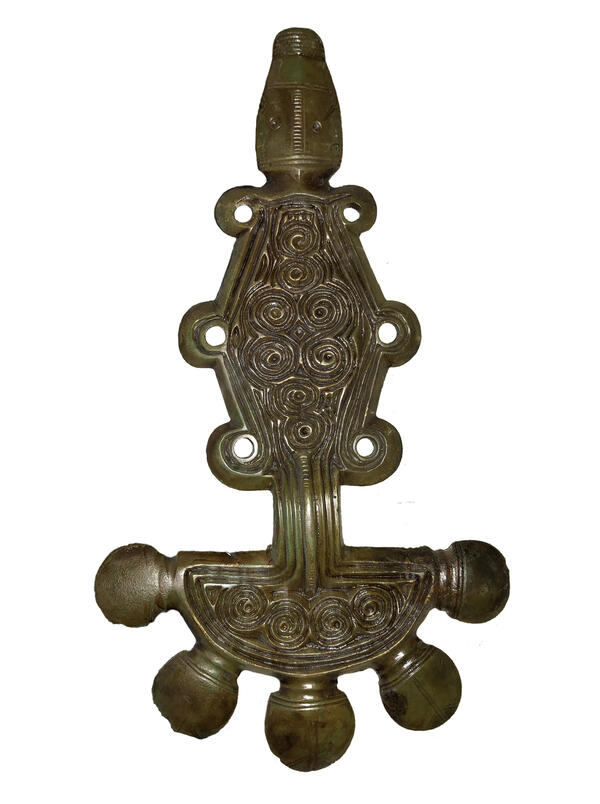The Kursk Regional Museum of Archaeology keeps a five-knobbed ornamented fibula, part of the Gaponovo hoard, which was discovered near the northeastern edge of the village of Gaponovo (Krasnooktyabrskoye), (Korenevsky district, Kursk region). The fibulae, metal decorative clasps of different shapes, were common from the Bronze Age to the late Middle Ages.
Like most of the finds of ancient artifact hoards, this one was found by chance. There was a pioneer camp belonging to the low-voltage equipment factory “Rubilnik” on this territory. The hoard was discovered by local workers while laying a pipeline to the pioneer camp’s bathhouse. Elena Yurievna Arkhipova, the head of the chamber laboratory of the Left Bank Early Slavic Expedition of the Institute of Archaeology of the Russian Academy of Sciences, was on the site at the time. She documented the find and collected most of the items. An archaeological trench was dug at the site and research began. The hoard was in the archaeological deposit, and, according to its finders, it was a dense spindle-shaped group of objects. A total of 488 items were found.
The described fibula was cast from copper alloy. The headplate has a semicircular shape and is flanked by five rounded protrusions — “fingers” — on short relief grooves — “necks” — with “waists”. The ornament on the front side of the plate consists of four large spiral compositions arranged in an arc. The foot of the fibula is in the form of an elongated hexagon, with three pairs of protrusions with through holes in the center at the corners. The front surface of the foot is ornamented with eight groups of spiral circles, which envelope the three curved lines going to the headplate of the piece. The fibula ends with a massive spur representing a heavily stylized animal head. Two transverse incised lines are featured on it. The eyes of the beast are depicted by small circles with dots in the center. The upper and lower shields are connected by a wide curved bow. On the reverse side of the decoration, there are two rounded eyes with holes for fixing a spring axis and a hooked, solidly cast needle holder. The needle itself is not preserved.
Like most of the finds of ancient artifact hoards, this one was found by chance. There was a pioneer camp belonging to the low-voltage equipment factory “Rubilnik” on this territory. The hoard was discovered by local workers while laying a pipeline to the pioneer camp’s bathhouse. Elena Yurievna Arkhipova, the head of the chamber laboratory of the Left Bank Early Slavic Expedition of the Institute of Archaeology of the Russian Academy of Sciences, was on the site at the time. She documented the find and collected most of the items. An archaeological trench was dug at the site and research began. The hoard was in the archaeological deposit, and, according to its finders, it was a dense spindle-shaped group of objects. A total of 488 items were found.
The described fibula was cast from copper alloy. The headplate has a semicircular shape and is flanked by five rounded protrusions — “fingers” — on short relief grooves — “necks” — with “waists”. The ornament on the front side of the plate consists of four large spiral compositions arranged in an arc. The foot of the fibula is in the form of an elongated hexagon, with three pairs of protrusions with through holes in the center at the corners. The front surface of the foot is ornamented with eight groups of spiral circles, which envelope the three curved lines going to the headplate of the piece. The fibula ends with a massive spur representing a heavily stylized animal head. Two transverse incised lines are featured on it. The eyes of the beast are depicted by small circles with dots in the center. The upper and lower shields are connected by a wide curved bow. On the reverse side of the decoration, there are two rounded eyes with holes for fixing a spring axis and a hooked, solidly cast needle holder. The needle itself is not preserved.




